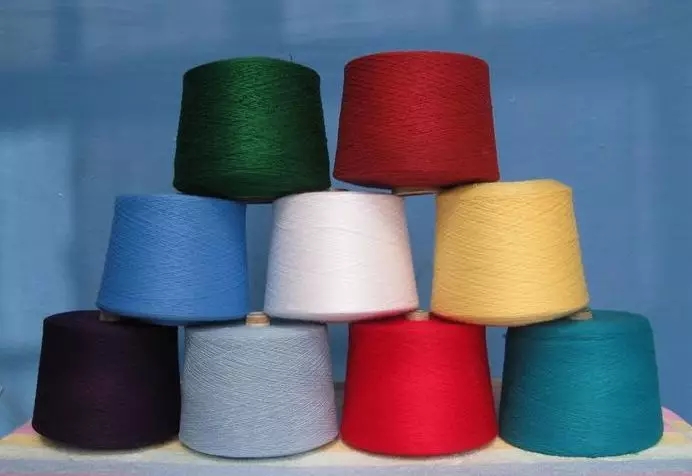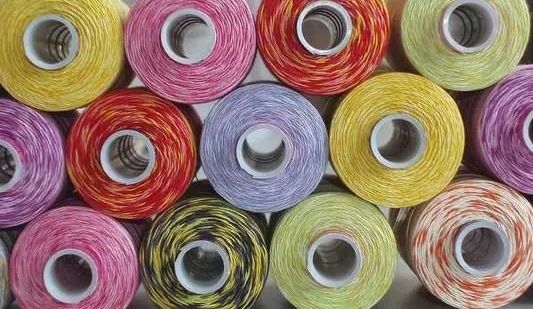01.Yarn is divided by spinning process
Combed yarn: yarn spun through a combing process. Compared with carded yarn, it uses better materials, the fibers in the yarn are straight and parallel, the yarn quality is excellent, and the yarn fineness is finer. Carded yarn: yarn spun through a general spinning process. Also called carded yarn, cotton spinning and wool spinning are slightly different.
02.According to the fiber length of the yarn
Filament yarn: A yarn formed by merging, twisting or texturing one or more continuous filaments. Short fiber yarn: Short fiber is twisted and spun into yarn with a certain fineness, which can be divided into three types. (1) Cotton yarn: yarn made by pure spinning or blending of raw cotton or cotton fiber on cotton spinning equipment. (2) Medium-long fiber yarn: a yarn that is processed by medium-long fiber on cotton spinning or special equipment. (3) Wool-type yarn: yarn made by pure spinning or blending of wool fiber or wool-type fiber on wool spinning equipment. Long-filament and short-fiber composite yarn: yarns spun from short fibers and filaments by special methods, such as core-spun yarn, wrapping yarn, etc.
03.According to the types of fibers that make up the yarn

Pure spinning: yarn spun from a fiber is called pure spinning. When naming it, it is named with the word "pure" and the name of the fiber, such as pure polyester yarn, pure cotton yarn, etc.; blended yarn: yarn made by mixing two or more fibers. The naming rules for blended yarns are: when the raw material blending ratio is different, the larger ratio is first; when the ratio is the same, it is arranged in the order of natural fiber, synthetic fiber, and regenerated fiber. When writing, write the raw material ratio and fiber type together, and separate the raw material and the ratio with a semicolon "/". Such as polyester/cotton (65/35) yarn, wool/acrylic (50/50) yarn, polyester/viscose (50/50) yarn and so on. Twisted yarn: A yarn made by twisting two or more different fibers or single yarns of different colors. Blended yarn: A yarn made by combining two kinds of filaments to improve certain aspects of performance.
04.Yarn is divided by dyeing and finishing
Primary color yarn: The yarn that retains the original color of the fiber without any dyeing and finishing. Bleached yarn: A yarn with a whiter color after bleaching. Usually refers to cotton yarn and hemp yarn. Dyed yarn: yarns with various colors after dyeing. Color spinning: yarn spun from colored fibers. Singeing yarn: yarn with a smoother surface after singeing processing. Mercerized yarn; mercerized yarns include mercerized cotton yarn and mercerized wool yarn. Mercerized cotton yarn is treated in a certain concentration of lye to make the yarn have silky luster and higher strength; mercerized wool yarn is to remove the fiber scales in the wool yarn, making the yarn soft and too irritating to the skin.
05.Yarn is divided by yarn linear density

Cotton yarn is divided into coarse special (number) yarn, medium special (number) yarn, fine holding (number) yarn and super fine holding (number) yarn. Coarse special yarn: refers to yarn with a linear density of 32 tex or more. Mid-special yarn: refers to yarn with a linear density of 31-21 tex. Fine special yarn: refers to yarn with a linear density of 11-20 tex or more. Extra-fine special yarn: refers to yarn with a linear density of 10 tex and below.
06.According to the structure of the yarn
Yarn is composed of textile fibers and has a continuous strip with certain mechanical properties, fineness and flexibility. The so-called "yarn" is actually a collective term for "yarn" and "thread". It is generally defined as: yarn is a continuous thread-like object made of various textile fibers as raw materials. It is thin, soft, and adaptable. Basic properties required for textile processing and final product use. In textiles, "yarn" and "thread" are often defined separately. That is to say, "yarn" is the arrangement of many short fibers or filaments in a nearly row state, and they are rotated and twisted in the axial direction to form a certain strength and thread Density products, and "threads" are products made by twisting two or more single yarns, which are called threads or strands. Yarn can be divided into different types according to different classification basis. According to the structure and appearance of the yarn, it can be roughly divided into 10 kinds of yarn. Monofilament: refers to a continuous monofilament with a long length. Multifilament: refers to a tow in which two or more monofilaments are merged together. Twisted yarn; multifilament yarn formed by twisting. Composite twisted yarn: The twisted yarn is combined and twisted one or more times to form a composite twisted yarn. Textured yarn: The chemical fiber raw yarn is deformed to make it have appearance characteristics such as crimp, spiral, loop and so on. The purpose of processing is to increase the fluffy elasticity and elasticity of the craftsman's office. According to the performance characteristics of the shape, there are usually three kinds of stretch yarn, bulk yarn and network yarn. Single yarn: a single continuous strip formed by spinning short fibers. Strand: Two or more single yarns are combined and twisted. If it is formed by the combination of two single yarns, it is called a double-stranded thread, and three and more are called a multi-stranded thread. The strands are combined and twisted to become double-twisted strands. Fancy thread: Yarn with special appearance and color made by special technology, including fancy thread and fancy thread. It is formed by twisting core yarn, decorative yarn and fixed yarn on a pattern twisting machine. The surface has special appearance shapes or colors such as fiber knots, slubs, loops, braids, spirals, and waves. Bulk yarn: Bulk yarn is a plump yarn with high softness that is processed by the heat shrinkability (thermoplasticity) of praline fiber. The low-shrinkage and high-shrinkage polyester fibers are mixed in a certain ratio to make yarn, and then relax and heat set. In this way, the high-shrinkage fiber shrinks greatly to form a yarn core, and the low-shrinkage fiber shrinks little and is squeezed on the surface to form an arc, thereby making a fluffy yarn. Core-spun yarn: a yarn formed by using filament or short fiber yarn as the core and wrapping other fibers or yarns.
Tel:0311-87877888 / 0311-87035555 / 13831145889 / 15831121695
Fax: 0311-87810345 Email:duwei@boshitex.com
Add:2309 Shangde Plaza, No. 8 Kangle Street, Xinhua District,Shijiazhuang City, Hebei China
Technical Support:ronglida.net.cn ICP15019912-2